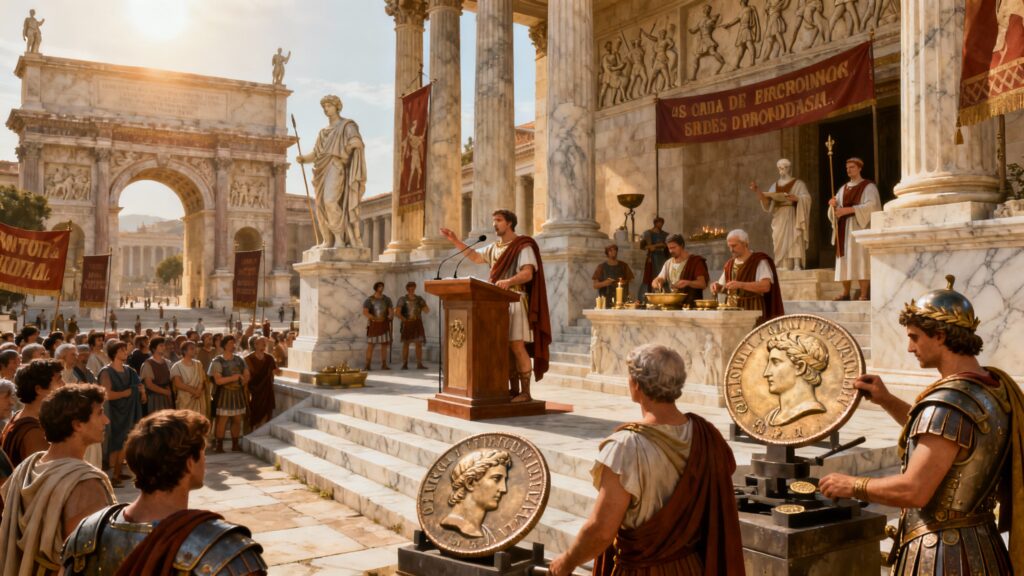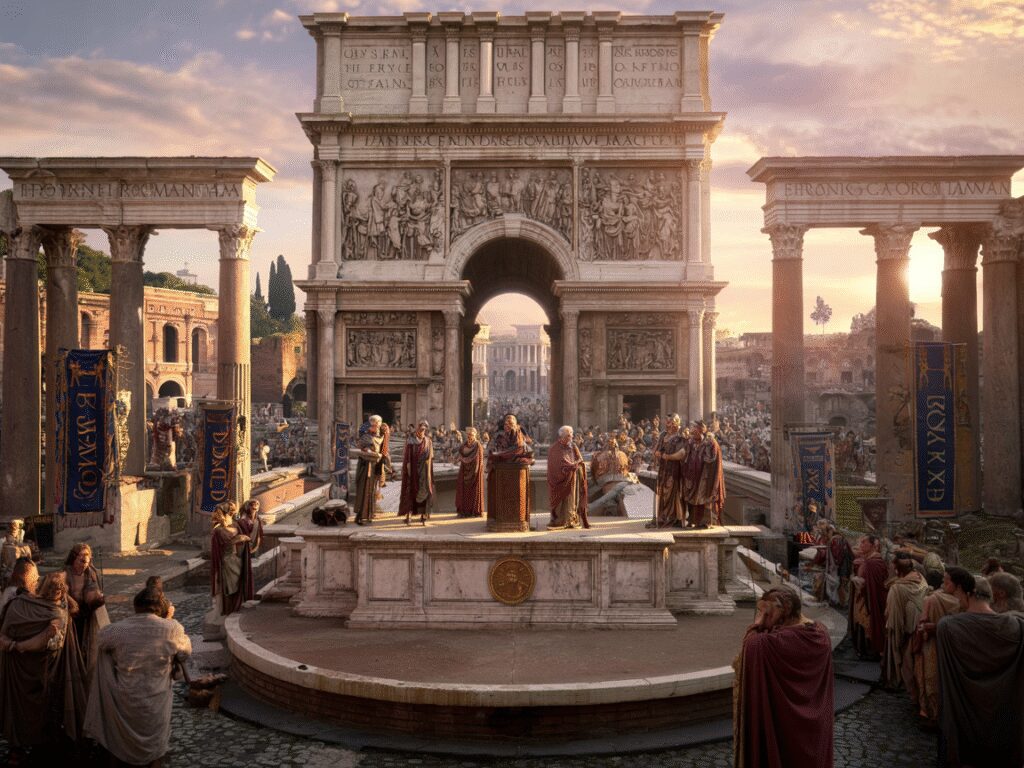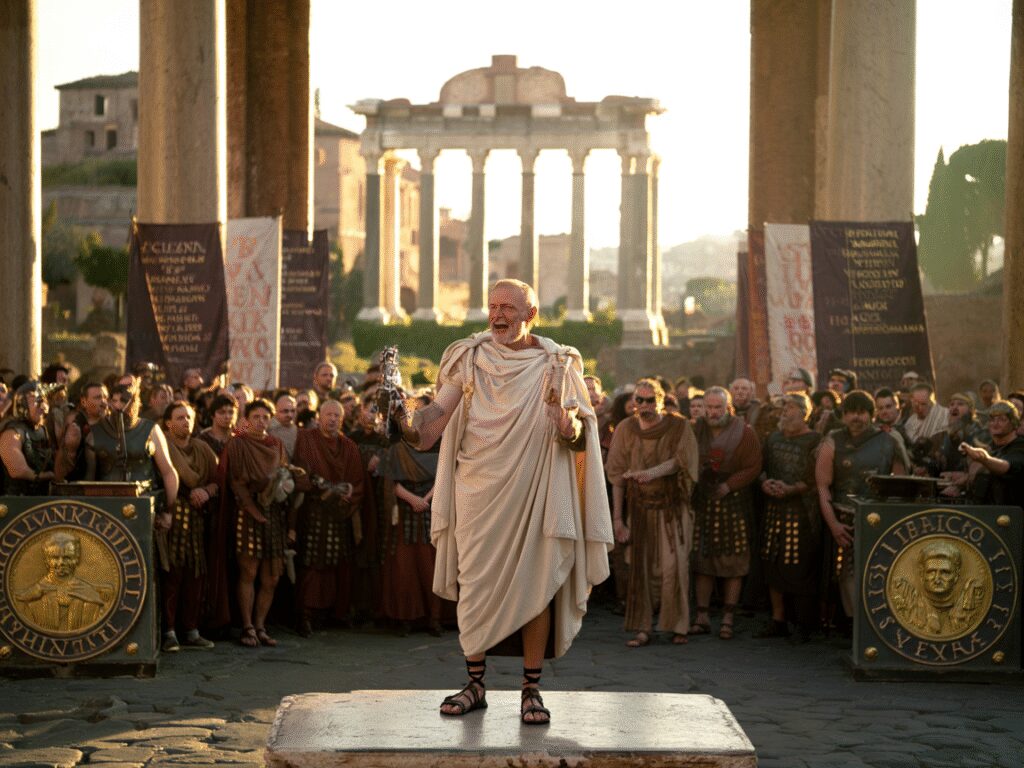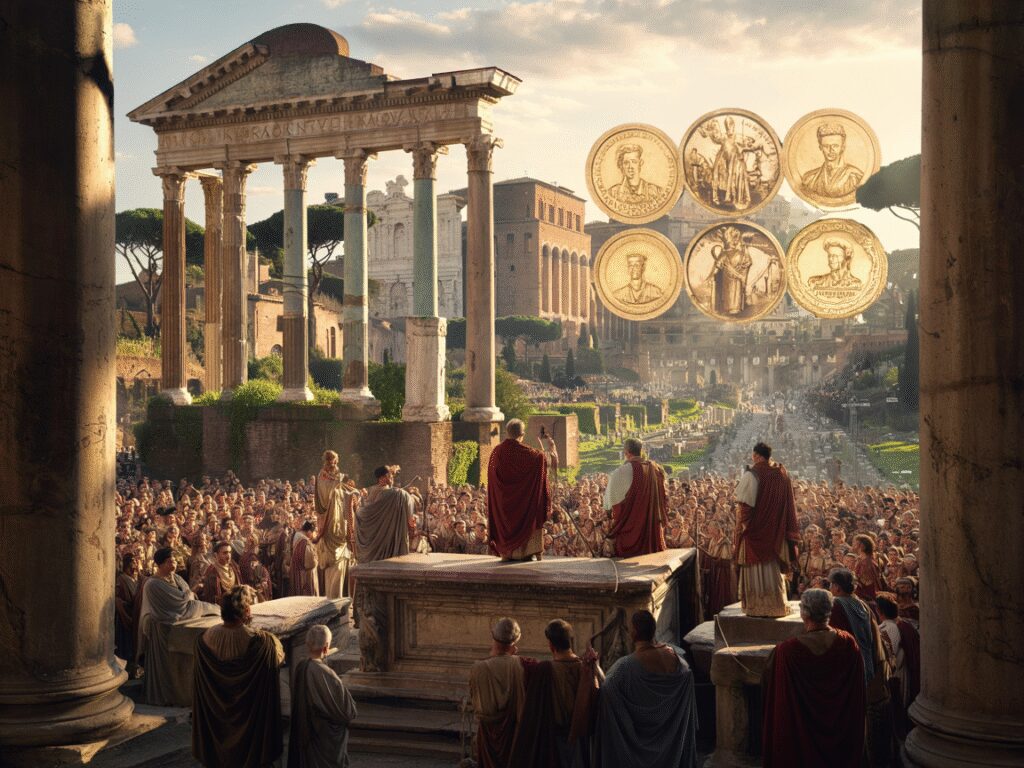Ancient Roman Disinformation: Manipulating Public Opinion Before Social Media reveals how sophisticated public opinion manipulation existed long before digital platforms. Ancient Roman disinformation involved deliberate spreading of misleading or biased information to control narratives, justify political actions, and maintain power.
Romans used various methods for propaganda such as literature, speeches, public monuments, coins, and religious rituals. These techniques shaped how people viewed their leaders and enemies, influencing both the elite and the general population throughout the empire. Even without modern technology, they were still able to create powerful stories that served their political purposes.
Studying these early forms of propaganda uncovers the roots of many information tactics still used today. Understanding pre-social media propaganda highlights how narratives are constructed to sway opinions, demonize adversaries, and legitimize authority—lessons crucial for recognizing and countering misinformation in our current media landscape.
The extensive trade and economy in Ancient Rome also played a significant role in shaping public opinion and political power through economic practices that influenced daily life and long-term stability.

The Foundations of Roman Disinformation
Roman propaganda techniques laid the groundwork for empire-building narratives that justified territorial expansion and political dominance. Leaders crafted stories presenting Rome not as an aggressor but as a civilizing force, bringing order and prosperity to “barbaric” lands. These narratives portrayed conquest as a moral duty sanctioned by the gods, reinforcing the legitimacy of imperial ambitions.
Myths and Legends: Shaping Public Perception
Myths and legends played a crucial role in shaping public perception. Tales of divine ancestry, heroic founders like Romulus and Remus, and gods favoring Rome created a powerful cultural mythology. For instance, the Roman Pantheon with its diverse collection of gods and goddesses, was central to this mythology. These stories fostered pride and loyalty among citizens while framing Rome’s enemies as threats to divine order. The blending of history and myth blurred lines between fact and ideology, making propaganda more persuasive.
Unifying Ideology: Graeco-Roman Values
Graeco-Roman values acted as a unifying ideology across diverse populations within the empire. Concepts such as virtus (courage), pietas (duty), and gravitas (seriousness) were promoted through education, public ceremonies, and literature. This shared cultural identity helped integrate conquered peoples by encouraging assimilation into Roman norms, reducing resistance to rule.
Key Elements of Roman Disinformation Foundations
Key elements of these foundations include:
- Crafting morally justified expansion narratives
- Employing myths to legitimize power and demonize enemies
- Promoting Graeco-Roman virtues to unify diverse groups under one imperial ideology
These early disinformation strategies set patterns for how Rome maintained control—through storytelling that influenced both elite opinion and popular belief. This control was further reinforced by the powerful Roman military, which was not merely a collection of soldiers but a well-oiled apparatus that combined discipline, strategy, and innovation.

Literary and Rhetorical Strategies in Roman Propaganda
Roman political communication excelled through literary and rhetorical mastery. Julius Caesar propaganda illustrates how written narratives shaped public perception. In his Commentarii de Bello Gallico, Caesar portrayed Germanic tribes as savage and threatening barbarians. This depiction justified his military campaigns as necessary for Rome’s peace and security, enhancing the empire’s image as a civilizing force.
Marcus Tullius Cicero elevated political speeches in Rome to new heights, using oratory to sway both Senate and populace. His extensive use of speeches, letters, poems, and even songs functioned like early content marketing tools—designed to reach diverse audiences with persuasive messages. Cicero’s rhetoric combined emotional appeal with logical argumentation, aiming to build his political brand.
Key techniques Cicero employed to discredit opponents included:
- Ad hominem attacks: Targeting personal character flaws rather than policy.
- Exaggeration of faults: Amplifying minor mistakes into major scandals.
- Suggesting conspiracy: Framing rivals as threats to Rome’s stability.
- Repetition: Reinforcing negative images through multiple speeches and writings.
These strategies influenced public opinion effectively, rallying support or undermining rivals such as Julius Caesar. However, the effectiveness of such strategies was often contingent on the political stability of the time. As seen in this analysis of political instability and weak leadership during the decline of the Western Roman Empire, such instability can undermine even the most powerful civilizations. Cicero’s rhetorical skill demonstrates how Roman leaders manipulated discourse well before modern media, crafting narratives that shaped political realities.
Visual and Architectural Messaging
Visual imagery was a powerful tool in Ancient Roman Disinformation: Manipulating Public Opinion Before Social Media. Roman statues symbolism played a key role in portraying emperors as embodiments of strength, wisdom, and benevolence. Statues strategically placed in public spaces reminded citizens daily of imperial authority and divine favor. Emperors appeared idealized—youthful, calm, commanding—to communicate stability and just rule.
The propaganda of imperial coins extended this message far beyond the city. These small pieces of currency went beyond their basic purpose and became significant instruments for political messaging, reinforcing loyalty by linking the ruler’s image with Rome’s success. Coins as Propaganda: The Currency of Power illustrate how coins circulated widely and bore the emperor’s portrait alongside symbols of peace, victory, or prosperity.
Public monuments messaging worked on a grand scale. Triumphal arches, temples, and forums demonstrated Rome’s military achievements and cultural dominance. Structures like the Colosseum or the Forum served as lasting illustrations of wealth and power accessible to all classes. They also functioned as shared landmarks that unified diverse populations under common Graeco-Roman ideals.
Architecture reinforced imperial legitimacy by embodying values such as order, permanence, and grandeur. The use of classical orders (Doric, Ionic, Corinthian) connected new constructions to revered traditions. The monumental scale impressed viewers, suggesting that the empire’s authority was unchallengeable. These visual and architectural elements operated as nonverbal yet unmistakable propaganda channels in Rome’s extensive toolkit for shaping public opinion.
In addition to these traditional methods, recent studies such as those presented in this J.Art.Arch.Stud article, have revealed more about the intricate ways architecture was used to convey messages of power and control in ancient Rome.

Techniques for Demonizing Enemies and Consolidating Power
Ancient Rome mastered the art of enemy demonization as a core facet of political strategy. Leaders crafted narratives that painted their adversaries not only as political opponents but as threats to civilization itself. These enemies were often depicted as barbaric, uncivilized forces or even as agents of divine punishment, challenging both the gods and the social order. This framing justified harsh reprisals and rallied public support behind those in power.
Political Rival Attacks
Political rival attacks frequently relied on unfounded accusations aimed at undermining credibility and loyalty. Cicero’s campaigns against Julius Caesar serve as a prime example. Cicero used rhetoric to portray Caesar as ambitious, dangerous, and morally corrupt — leveraging fear to sway opinion within the Senate and among Roman citizens. Such propaganda blurred lines between fact and fiction, turning political competition into battles of character assassination.
Strengthening Rulers’ Authority
These tactics did more than just discredit enemies; they strengthened rulers’ authority by creating a clear “us versus them” dynamic. By depicting dissenters as inherently untrustworthy or even evil, rulers justified suppressing opposition through legal or violent means. This consolidation of power depended heavily on public acceptance of these demonizing narratives, making propaganda a critical tool for maintaining control in Rome’s volatile political environment.
Parallels Between Ancient Roman Disinformation and Modern Social Media Propaganda
The study of ancient vs modern propaganda reveals striking similarities in how information is manipulated to influence public opinion. Roman leaders employed storytelling techniques that resonate with today’s digital campaigns. Both eras rely on shaping narratives that appeal emotionally and ideologically to their audiences.
Roman Content Marketing: The Early Platforms for Mass Communication
Roman content marketing took the form of speeches, poetry, public art, and monumental architecture. These served as early platforms for mass communication, much like social media posts, videos, and memes do now. Julius Caesar’s commentaries on the Germanic tribes, Cicero’s persuasive oratory, and imperial iconography functioned as carefully crafted messages designed to sway popular perception and legitimize power.
Key Information Manipulation Techniques
Key information manipulation techniques include:
- Repetition of simple, memorable themes (e.g., barbarism of enemies, benevolence of rulers)
- Emotional appeals through vivid storytelling and symbolism
- Strategic use of public spaces and media to reinforce dominant narratives
- Character assassination by discrediting opponents with unfounded claims
These methods mirror modern tactics found in social media disinformation campaigns, where emotional resonance often trumps factual accuracy. The Roman model underscores the importance of critical thinking when encountering persuasive messaging—be it from an ancient or digital source.
Lessons from Roman Propaganda for Understanding Contemporary Misinformation
Studying Roman propaganda provides valuable lessons for understanding contemporary misinformation challenges. Recognizing patterns in narrative construction, audience targeting, and visual symbolism helps decode the mechanics behind both centuries-old empires and today’s online influence operations.
Moreover, the influence of Roman society on Western civilization has been profound. From their legal systems to architectural marvels, the legacy of Rome is woven into the very fabric of contemporary society. This is evidenced by the enduring legacy of Roman law, which has significantly shaped modern legal structures across the globe.
Additionally, Roman art and sculpture have left a timeless legacy that continues to inspire. The masterpieces of Roman art reflect not only the aesthetic values of its time but also the social, political, and cultural dynamics that shaped the Roman world. Furthermore, the evolution of Roman sculpture showcases a distinct focus on realism and the portrayal of power, serving as instruments for political propaganda and religious devotion.

Conclusion
The legacy of Roman disinformation remains deeply embedded in the fabric of political communication. Ancient propagandists mastered techniques that continue to influence how power is projected and contested today. Understanding this historical propaganda impact offers critical insights into the mechanics behind both ancient and modern information warfare.
- Ancient Rome’s strategic use of storytelling, visual messaging, and rhetoric laid foundational principles still visible in contemporary propaganda.
- Recognizing these patterns sharpens your ability to identify manipulation tactics in today’s digital environments.
- Ancient Roman Disinformation: Manipulating Public Opinion Before Social Media reveals that misinformation is not a new phenomenon but a persistent element of human society.
Applying lessons from Roman history empowers you to approach modern disinformation campaigns with a more informed and critical perspective, enhancing efforts to safeguard truth and transparency in political discourse.
FAQs (Frequently Asked Questions)
What was the role of disinformation in Ancient Rome before the advent of social media?
In Ancient Rome, disinformation played a crucial role in manipulating public opinion by crafting narratives that justified empire expansion, unified diverse populations, and consolidated political power without the need for digital platforms.
How did Roman leaders use myths and legends to influence public perception?
Roman leaders strategically employed myths and legends rooted in Graeco-Roman values to shape cultural identity and create compelling stories that supported their imperial ambitions and legitimized their rule.
What literary and rhetorical strategies did figures like Julius Caesar and Cicero use for propaganda?
Julius Caesar portrayed Germanic tribes in ways that enhanced Rome’s image, while Cicero utilized speeches, letters, and poems as early content marketing tools to discredit opponents and sway public opinion effectively.
In what ways did visual art and architecture serve as propaganda tools in Ancient Rome?
Roman statues, imperial coins, public monuments, and buildings symbolized benevolent leadership, demonstrated wealth and success, and reinforced shared cultural identity and imperial legitimacy among the populace.
How were enemies demonized in Roman political propaganda to consolidate power?
Romans crafted narratives depicting enemies as barbaric or divine punishments for defiance; unfounded accusations during political rivalries—such as Cicero’s campaigns against Julius Caesar—strengthened rulers’ authority and suppressed dissent.
What parallels exist between Ancient Roman disinformation techniques and modern social media propaganda?
There are notable similarities in storytelling methods across millennia; Roman content marketing through speeches and art parallels today’s digital campaigns, offering valuable lessons for understanding and combating contemporary misinformation challenges.

